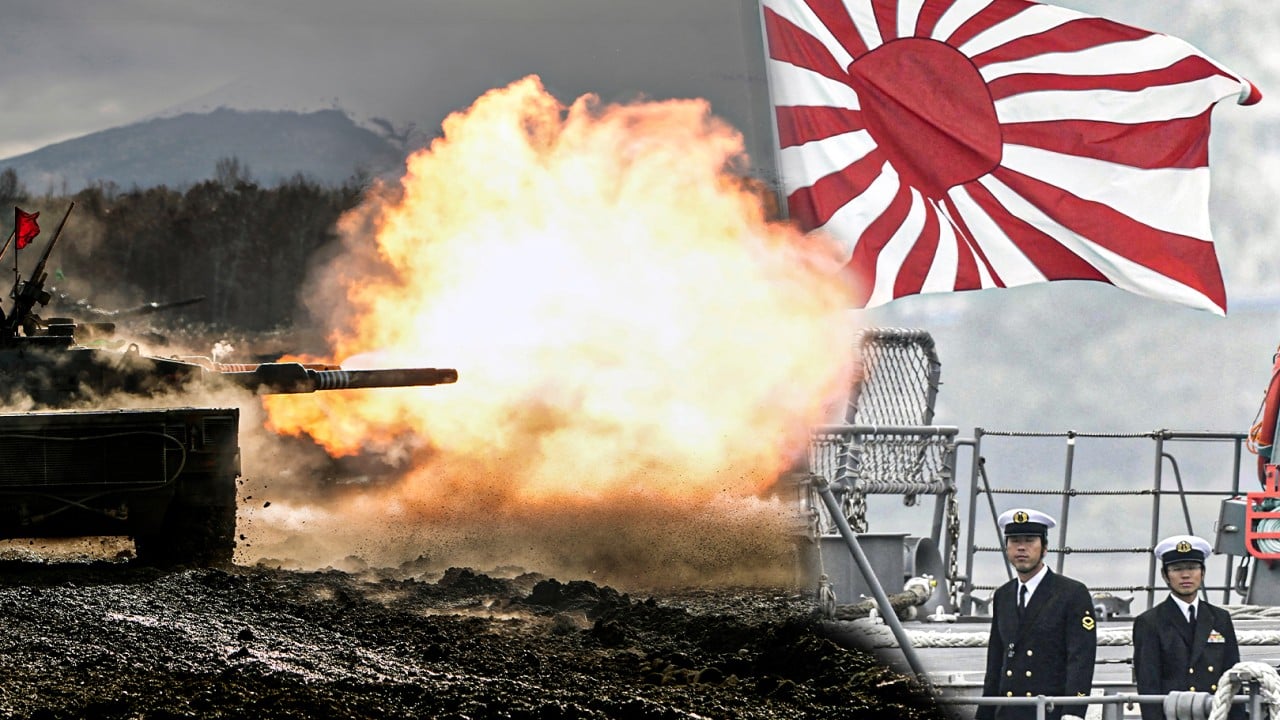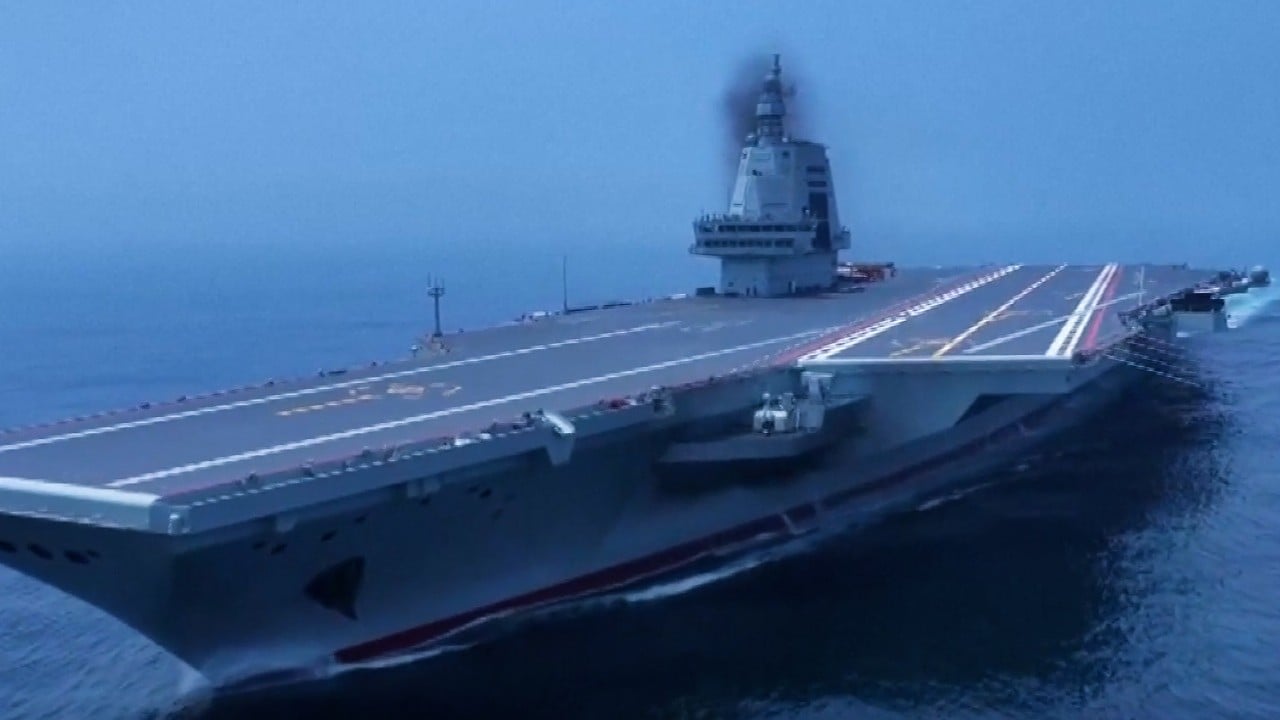The Chinese aircraft carrier Shandong’s presence in the Philippine Sea and the South China Sea this week is a show of presence and increased combat readiness as a US aircraft carrier group sailed in the area en route to the Middle East, experts say.
The Shandong was spotted on Monday sailing with three other vessels – China’s Type 055 guided-missile destroyer Yanan, Type 051 destroyer Zhanjiang and Type 054A guided-missile frigate Yuncheng – Japan’s Joint Staff Office said in a press release on Wednesday.
The four ships were seen around 530km (329 miles) south of Yonaguni Island in Japan’s Okinawa prefecture in the Philippine Sea.
“Additionally, approximately 20 take-offs and landings by carrier-based fighter jets and carrier-based helicopters from the Chinese navy’s Kuznetsov-class aircraft carrier Shandong were confirmed,” Japan’s Joint Staff Office said.
The statement said the four People’s Liberation Army naval vessels sailed back towards the South China Sea after their activities in the Philippine Sea on Monday where the Japanese destroyer Akizuki conducted surveillance and gathered intelligence regarding the Chinese carrier strike group.
The Shandong, the mainland’s first domestically built and the PLA’s second aircraft carrier, had previously deployed in the Philippine Sea from July 9 to 18 when it carried out an exercise off the southeastern coast of Taiwan near the Bashi Channel.
The carrier was also seen conducting ship-borne aircraft operations in the Philippine Sea south of Japan’s Miyako Island and east of the Philippines’ Luzon Island for about a week in October.
The Shandong’s passage from the Philippine Sea to the South China Sea comes as the American aircraft carrier USS Abraham Lincoln and its carrier strike group is transiting the South China Sea on its way to the Middle East.
According to the US Naval Institute’s online news portal USNI News, the Abraham Lincoln was in the Sulu Sea between the Philippines’ Palawan and Mindanao islands on Monday and was expected to then travel through the South China Sea. US Secretary of Defence Lloyd Austin had reportedly issued the order to “accelerate” the carrier striker group’s voyage towards the Middle East amid increasing tensions between Israel and Iran.
While the US and Chinese aircraft carriers were distant from each other, Malcolm Davis, a senior analyst at the Australian Strategic Policy Institute, said the Shandong’s route was a classic case of “showing the flag” as the US and allied navies carried out naval exercises in the South China Sea.
“China has responded to the deployment of the Lincoln with a deployment of its own carrier task force centred around the Shandong,” Davis said.
“It is not unreasonable for the [PLA Navy] to make this deployment, and this is traditional naval activity for most navies – seeking to ‘fly the flag’ and demonstrate presence.”
Timothy Heath, a senior international defence researcher at the Rand Corporation think tank, said the main significance of the Shandong’s activities was that the PLA Navy showed it could conduct two deployments with a short break, displaying its increased combat readiness.
“Operations outside the first island chain also show that the PLA is improving its ability to operate in distant locations far from China’s shores,” he said.
“There is possibly a political message as well to Taiwan and to the Chinese people, which is that the PLA has the ability to cut off Taiwan from all directions and is thus in a militarily strong position.”
Stephen Nagy, director of policy research at the Yokosuka Council on Asia-Pacific Studies, said Washington had an “intact, operational and war-experienced navy for more than 80 or 90 years”, while the Chinese were at the beginning stage of their naval experience.
“This gap will be difficult to overcome, but that is the long-term objective of the Chinese.
“It’s important to demonstrate that the Shandong cannot only transit from the Philippine Sea to the South China Sea, but again, it’s … coordinating and creating interoperability opportunities between China and its partners, such as Russia Pacific Fleet. Whether this will translate into reality or not, that’s a different story.”
The importance of the South China Sea as an international waterway connecting Europe and the Indo-Pacific region was also underscored in the passage last week of the Russian Pacific Fleet cruiser Varyag and frigate Marshal Shaposhnikov through the Malacca Strait near the South China Sea after deployment in the Mediterranean Sea.
Last month, the Chinese and Russian navies conducted a joint live-fire naval exercise in the South China Sea involving air defence and anti-submarine drills, around the time the US and Philippine coastguards conducted joint training in the same waters.
On Tuesday, the Philippine navy criticised Chinese aircraft manoeuvres over the disputed Scarborough Shoal in the South China Sea, in which flares were reportedly dropped in the path of Philippine military aircraft while conducting a routine patrol near the atoll.
Davis said that in a hypothetical conflict in the South China Sea, the Chinese would pursue a “counter intervention strategy” based around anti-access and area denial (A2/AD) to deny access and prevent operational manoeuvres within key maritime areas.
“The South China Sea is hugely important, not just in terms of a means to access the Indian Ocean, and on to the Middle East, but in terms of being the centre of Indo-Pacific economic growth and prosperity,” he said.
Collin Koh, a senior fellow at the S. Rajaratnam School of International Studies in Singapore, said the South China Sea would have an increasing international maritime force policing the area under a mandate, considering it was an “important conduit for seaborne trade”.
“We might also expect it to be more than just an operation involving the international or foreign naval powers,” Koh said, adding that he expected that other regional countries in Southeast Asia such as Japan would want active involvement.
“It is going to be much more messy and more complicated in the South China Sea compared to the one that we see right now in the western Indian Ocean,” Koh said.




